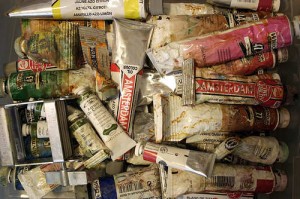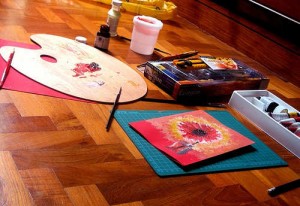Oil Painting Terms: Part Three
Oiling out – The application of an oil medium to a painting that has sunk (become dull) or lost its oil to the layer underneath. Artist’s painting medium should be rubbed sparingly into any sunken areas with a clean cloth, wiping off any residue, allowing to dry for a few days and repeating as necessary until an even sheen is obtained throughout.
Optical Colour Mixture – The tendency of the eyes to blend patches of individual colours placed near one another so as to perceive a different, combined colour. Also, any art style that exploits this tendency, especially the pointillism of Georges Seurat.
Organic – An image that shows a relationship to nature as opposed to man-made images. Any shape that resembles a naturally occurring form or that suggests a natural growing or expanding process.
Painted Edges – Not all canvasses are framed. Instead, some are intended to be hung without frames. If this is the artist’s intention, the artist will often paint over the edges of the canvas onto the sides. This not only allows the painting to be hung unframed, but also creates the interesting effect of extending the painting into three dimensions.
Pastel – A colored crayon that consists of pigment mixed with just enough of an aqueous binder to hold it together; a work of art produced by pastel crayons; the technique itself. Pastels vary according to the volume of chalk contained and the deepest in tone are pure pigment. Pastel is the simplest and purest method of painting, since pure colour is used without a fluid medium and the crayons are applied directly to the pastel paper or card.
Pentimento – A condition of old paintings where lead-containing pigments have become more transparent over time, revealing earlier layers.
Perspective – The representation of three-dimensional objects on a flat surface so as to produce the same impression of distance and relative size as that received by the human eye. In one-point linear perspective, developed during the fifteenth century, all parallel lines in a given visual field converge at a single vanishing point on the horizon. In aerial or atmospheric perspective, the relative distance of objects is indicated by gradations of tone and color and by variations in the clarity of outlines.
Pictorial Space – The illusory space in a painting or other work of two-dimensional art that seems to recede backward into depth from the picture plane, giving the illusion of distance.

Picture Plane – An imaginary flat surface that is assumed to be identical to the surface of a painting. Forms in a painting meant to be perceived in deep three-dimensional space are said to be “behind” the picture plane. The picture plane is commonly associated with the foreground of a painting.
Pigment – Dry coloring matter, usually an insoluble powder to be mixed with a liquid to produce paint.
Pochoir – A stencil and stencil-brush process for making muticoloured prints, and for tinting black-and-white prints, and for coloring reproductions and book illustrations, especially fine and limited editions. Pochoir, which is the French word for stencil, is sometimes called hand-coloring or hand-illustration. Pochoir, as distinguished from ordinary stencil work, is a highly refined technique, skillfully executed in a specialized workshop.
Positive Space – The space in a painting occupied by the object depicted (not the spaces in-between objects).
Provenance – The record of ownership for a work of art, ideally from the time it left the artists studio to its present location. French for source or origin.
Replica – An exact copy of an original work of art that is made by, or under the supervision of, the original artist.
Repoussoire – From the French verb meaning to push back. A means of achieving perspective or spacial contrasts by the use of illusionistic devices such as the placement of a large figure or object i the immediate foreground of a painting to increase the illusion of depth in the rest of the picture.
Reproduction – A mechanically produced copy of an original work of art (as distinct from replicas which are one-offs).
Semblance – A picture consisting of a graphic image of a person or thing.
Shading – Showing change from light to dark or dark to light in a picture by darkening areas that would be shadowed and leaving other areas light. Shading is often used to produce illusions of dimension and depth.
Signature – An artists name physically signed (or carved) on a work of art usually providing evidence that the work is entirely by the hand of the artist who signs the work. The Signing of prints is usually done using a soft base pencil in order that it’s dark, clearly visible and does not fade over time.
Silhouette – The outer shape of an object. An outline, often filled in with color.
Simultaneous Contrast – The tendency of complementary colors to seem brighter and more intense when placed side by side.
Study – A detailed drawing or painting made of one or more parts of a final composition, but not the whole work.
Style – A characteristic or a number of characteristics that can be identified as being embodied in a work of art. Typically associated with a specific artist, group of artists, culture, or a specific artists work during a particular time period. “In the style of …. ” means that the work resembles a particular artists style but is not actually created by that artist. “In the studio of …. ” means that the work was created by a student, apprentice or colleague of a particular artist whose style it resembles and possibly supervised by that artist.

Support – The surface, or material, on which an artist creates two-dimensional art. Can be canvas, paper, cardboard or wood panel. The surface often has to be treated before the paint is applied so as to neutralize any natural acidities and protect the work from discolouration or deterioration.
Tempera – Medium, typically egg yolk which was used in the Renaissance prior to the advent of oil and has benefited from a recent revival.
Tonality – The overall color effect in terms of hue and value. Often one dominating hue is employed in various shades and values.
Triptych – A painting or carving consisting of three panels.
Underpainting – The traditional stage in oil painting of using a monochrome or dead color as a base for composition. Also known as laying in.
Vanishing Point – In linear perspective, the point on the horizon line where parallel lines appear to converge.
Vignette – A small illustrative sketch or painting that appears to float suspended on a surface.
Wash – Used in watercolor painting, brush drawing, and occasionally in oil painting and sculpture to describe a broad thin layer of diluted pigment, ink, glaze or patina. Also refers to a drawing made in this technique.
Yellowing – This effect on oil paintings is usually caused by one of three reasons: excessive use of linseed oil medium; applying any of the varnishes that are prone to yellow with age; or most often – an accumulation of dirt embedded into the varnish.
Image source: www.wikihow.com
